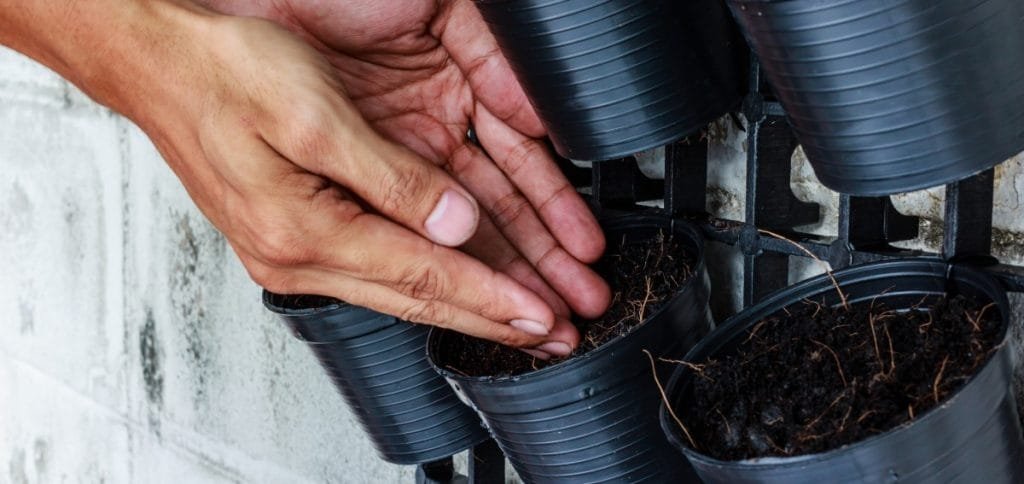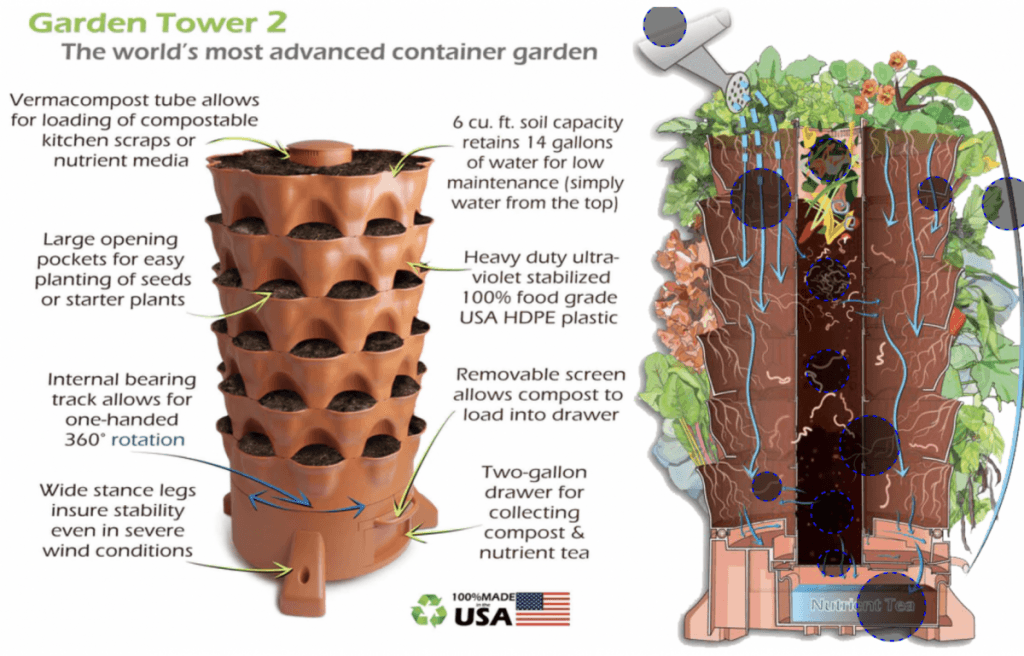Vertical gardens are great for utilizing vertical space — making them an excellent option for growing food and flowers in small spaces. If you’re new to vertical gardening, you may find yourself wondering which soil is best to use?
Generally, you’ll find that the best soil for a vertical garden is good-quality, loam-based potting soil. To recreate this soil type, mix equal parts peat moss, garden loam, and builder’s sand. This way, you’ll have a high-mineral, well-draining, moisture-retaining soil, perfect for a vertical garden.
Below, we’ll look at everything that determines which soil is best to use in your vertical garden and ensure that your plants continue to grow and thrive.

How To Create A Soil Mix Perfect For Your Vertical Garden
The secret to excellent potting soils is the mineral content. Generally, you’ll find potting soils enriched with:
- Perlite
- Volcanic materials
- Vermiculite
- Sand
- Bentonite
These are added because they generally don’t decompose and usually add minerals that typical soils lack. These components are lightweight, which is important for vertical gardening.
Clay soils are dense, and when they dry out, they become virtually uninhabitable. The poor drainage creates a moisture backlog, and it’s considered difficult soil to use in a vertical garden.
Using clay soil is also a bad idea because of how dense and heavy it is. It can easily weigh down your plant containers, causing the entire plant structure to sag, and deteriorate.
Sandy soils are excellent if you want well-draining soil, but they’re prone to drying out quickly because of how light the soil is and the lack of organic components in it.
Creating soil that drains water effectively while retaining moisture is a perfect balance. The best way to build a healthy soil is to add organic matter on a regular basis.
Check out my recent post on how to start a vertical garden
What Kind Of Organic Matter Can I Add To My Soil?
Well-draining, moisture-retaining soil sounds nearly impossible, but that’s where organic matters come into play. Here are common types of organic matter that retain moisture and make for great additions to soil:
- Peat moss
- Sphagnum moss
- Sawdust
- Leaf molds
- Shredded bark
- Compost
What’s great about using these materials is that they take longer to break down than standard commercial fertilizers. The slow deterioration of the material means that they act as a slow-releasing fertilizer and help maintain and develop plant-bacteria vital to healthy plant growth.
Home composting is a great way to turn your organic food scraps into nutrient rich soil to add into your vertical garden. I have a few worm buckets in my garage that I fill with table scraps and harvest for worm castings and worm tea.
- US made with durable high quality plastic. Houses thousands of worms that can consume several...
- The Worm Factory 360 has a standard 4-Tray size which is expandable up to 6 trays when...
- Each tray has a grid bottom for worms to migrate upward as new food is added. As each tray is...
The Formula To Create A Perfect Soil
Generally, you’ll find indoor gardeners recommending the following ratios because a balanced soil and organic matter combination will provide the perfect structure for most plants.
- One-third of peat moss or matured compost
- One-third of garden loam or topsoil
- One-third of the builder’s sand or any organic matter suggestions (perlite, vermiculite, etc.)
You may find that some plants require minor adjusting to this formula — orchids, for example, require more organic matter compared to soil.
It’s best to experiment and find the perfect ratio for your specific gardening needs. It’s also good practice to fertilize with a slow-release fertilizer to encourage plant growth. Topping up your soil with fresh organic material on a regular schedule will replenish the nutrients removed from your fruits and vegetables.
If you want to try vertical gardening without soil consider all the benefits that a hydroponic vertical Tower Garden has in my recent article.
Self Fertilizing Vertical Garden
The Garden Tower 2 is a soil based stand alone vertical gardening system that integrates soil building and fertilization naturally. The UV stabilized food grade vertical planter can hold 50 plants and easily rotates by hand.
The all in one system combines a center tube for vermiculture (worms) composting of your kitchen scraps providing a constant nutrient supply to the plant roots. The bottom of the tower has an easily accessible compartment and door to collect the worm tea and organic compost.


Types Of Soil And Which Are Best For Gardening
Knowing the soil types and their properties will help you support a healthy plant. Soil can be categorized into Loam, sand, clay, silt, peat and chalk categories and are generally determined by the size of the particles within the soil.
Loam Soil
Loam soil is considered the perfect gardening soil as it combines sand, silt, and clay soils to counteract the adverse effects that each soil introduces.
Loam soils are fertile, easy to work with and provide good drainage. Depending on the ratios of the soils, loam soil can either be sandier or more clay-like.
This soil is the gardener’s best friend but still benefits from being topped up with additional organic matter to improve the soil quality even more!
Sandy Soil
Sandy soil has the following properties:
- Light
- Warm
- Dry
- It tends to be acidic
Sandy soils are known as ‘light soils’ due to the small proportion of clay and high amounts of soil. This type of soil tends to be well-draining and is easy to work in many gardens.
Sandy soil is known to dry out quickly in springtime and has a low nutrient count due to its porous quality. Adding organic matter, like peat moss or matured compost, will help the soil to maintain nutrients and water for a longer time.
Clay Soil
Clay soil is excellent if you want nutrient-rich and moisture-retaining soil. This soil generally comprises +25% clay and, because of the dense nature of the soil, can retain large amounts of water.
It’s also slow to drain and takes a long time to warm up and dry out during the summer. While these properties sound appealing, they may prove a challenging environment for certain plants that need better drainage.
Silt Soil
Silt soil is light and generally maintains water quite well. It’s also considered very fertile soil. This soil drains well while maintaining moisture and is prone to wash away with rain.
If you want to use silty soil in your vertical garden, it’s best to add some organic matter, like peat moss, to ensure it is stable and doesn’t act too much like clay soil.
Peat Soil
Peat soil is rarely found to occur in gardens naturally. This type of soil contains great amounts of organic components and retains a lot of moisture without suffocating the plant.
This type of soil is generally what you want to use as base soil in your garden. In a vertical garden, you may want to use this soil to enrich existing soil and create the ideal soil-environment for growing fruits and vegetables.
Chalk Soil
Chalk soil is the least optimal soil to use in a gardening context due to the high alkalinity created by lime (calcium carbonate) within the soil. This soil is usually only used to neutralize acidic soils or plants that thrive in alkaline conditions.
How To Match Your Soil Type To Your Plant
Outdoor plants are generally hardy enough to withstand outdoor conditions — the game changes when you look at the requirement of indoor plants.
Vertical gardens generally contain delicate plants that require a more controlled environment. But what does this mean for the soil? Nearly all general garden soils don’t offer enough nutrients, water, and even air.
For this reason, you need potting soil that’s specifically formulated to fill the voids generated by standard garden soils.
If you live in a colder climate find out all the pros and cons to indoor vertical gardens in my latest post.
Buying Soil For Your Vertical Garden
Soil is one of the essential variables when it comes to gardening. Other than water, nothing is more important than producing healthy and green plants. Fortunately, it’s not difficult to create the perfect growing environment in a vertical space.
Because soil is such a fundamental part of gardening, especially in a vertical garden, you’ll find many guidelines for creating the perfect soil for your specific gardening needs.
Garden centers are also equipped to answer any question you have about soil — and if you’re not into asking the employees, most packages will contain information about the soil composition. There are typically only a few types of soil suited for gardening, making searching for the perfect medium even easier!
Conclusion
If you’re limited on floor space for a garden, vertical gardens are the perfect option for you. The type of soil you choose to use in your vertical garden is just as important as how frequently you water your plants.
Choosing a suitable medium to grow your plants in is easy once you understand what types of soils are readily available to you.
You’ll find that most vertical gardens benefit from equal parts peat moss, garden loam, and builder’s sand. There are also good alternatives to each of these and can be substituted with what you have available. Your vertical garden will thank you for using soil optimized for growth, moisture retention, and water drainage.

